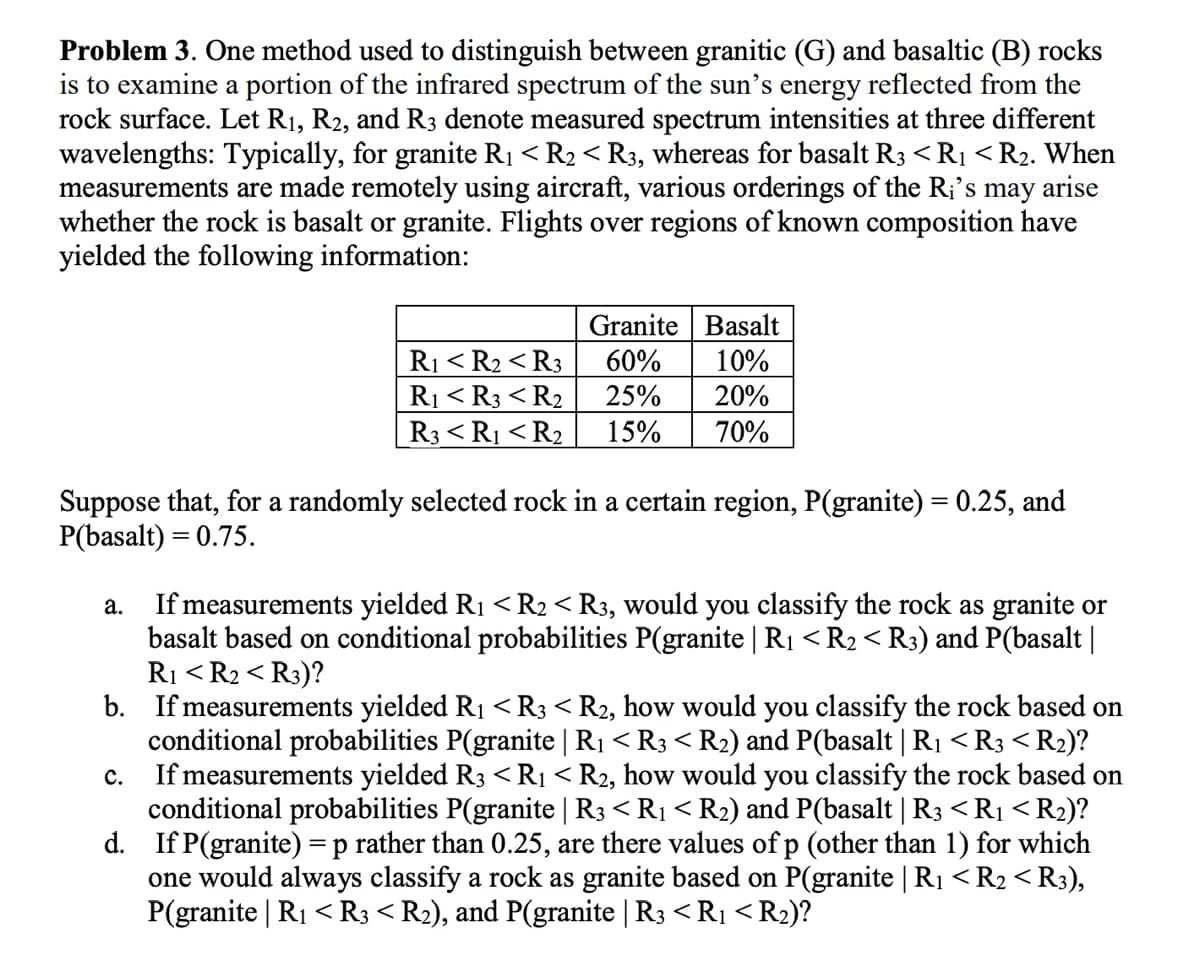Problem 3. One method used to distinguish between granitic (G) and basaltic (B) rocks is to examine a portion of the infrared spectrum of the sun's energy reflected from the rock surface. Let R1, R2, and R3 denote measured spectrum intensities at three different wavelengths: Typically, for granite R₁ < R2 < R3, whereas for basalt R3
Problem 3. One method used to distinguish between granitic (G) and basaltic (B) rocks is to examine a portion of the infrared spectrum of the sun's energy reflected from the rock surface. Let R1, R2, and R3 denote measured spectrum intensities at three different wavelengths: Typically, for granite R₁ < R2 < R3, whereas for basalt R3
Algebra: Structure And Method, Book 1
(REV)00th Edition
ISBN:9780395977224
Author:Richard G. Brown, Mary P. Dolciani, Robert H. Sorgenfrey, William L. Cole
Publisher:Richard G. Brown, Mary P. Dolciani, Robert H. Sorgenfrey, William L. Cole
Chapter4: Polynomials
Section4.9: Area Problems
Problem 10P
Related questions
Question
Help me with my homework

Transcribed Image Text:Problem 3. One method used to distinguish between granitic (G) and basaltic (B) rocks
is to examine a portion of the infrared spectrum of the sun's energy reflected from the
rock surface. Let R1, R2, and R3 denote measured spectrum intensities at three different
wavelengths: Typically, for granite R₁ < R2 < R3, whereas for basalt R3 <R₁ <R2. When
measurements are made remotely using aircraft, various orderings of the Ri's may arise
whether the rock is basalt or granite. Flights over regions of known composition have
yielded the following information:
Granite Basalt
R1 < R2 < R3
60%
10%
R1 < R3 < R2
25%
20%
R3 <R1 <R2
15%
70%
Suppose that, for a randomly selected rock in a certain region, P(granite) = 0.25, and
P(basalt) = 0.75.
a.
If measurements yielded R₁ < R2 < R3, would you classify the rock as granite or
basalt based on conditional probabilities P(granite | R₁ <R2 < R3) and P(basalt |
R1 < R2 < R3)?
b. If measurements yielded R₁ < R3 < R2, how would you classify the rock based on
conditional probabilities P(granite | R1 < R3 < R2) and P(basalt | R1 < R3 <R2)?
C. If measurements yielded R3 < R₁ < R2, how would you classify the rock based on
conditional probabilities P(granite | R3 < R1 < R2) and P(basalt | R3 <R1 < R2)?
d. If P(granite) = p rather than 0.25, are there values of p (other than 1) for which
one would always classify a rock as granite based on P(granite | R1 < R2 < R3),
P(granite | R₁ < R3 < R2), and P(granite | R3 <R₁ <R2)?
Expert Solution
This question has been solved!
Explore an expertly crafted, step-by-step solution for a thorough understanding of key concepts.
This is a popular solution!
Trending now
This is a popular solution!
Step by step
Solved in 2 steps

Recommended textbooks for you

Algebra: Structure And Method, Book 1
Algebra
ISBN:
9780395977224
Author:
Richard G. Brown, Mary P. Dolciani, Robert H. Sorgenfrey, William L. Cole
Publisher:
McDougal Littell

Trigonometry (MindTap Course List)
Trigonometry
ISBN:
9781305652224
Author:
Charles P. McKeague, Mark D. Turner
Publisher:
Cengage Learning

Algebra: Structure And Method, Book 1
Algebra
ISBN:
9780395977224
Author:
Richard G. Brown, Mary P. Dolciani, Robert H. Sorgenfrey, William L. Cole
Publisher:
McDougal Littell

Trigonometry (MindTap Course List)
Trigonometry
ISBN:
9781305652224
Author:
Charles P. McKeague, Mark D. Turner
Publisher:
Cengage Learning